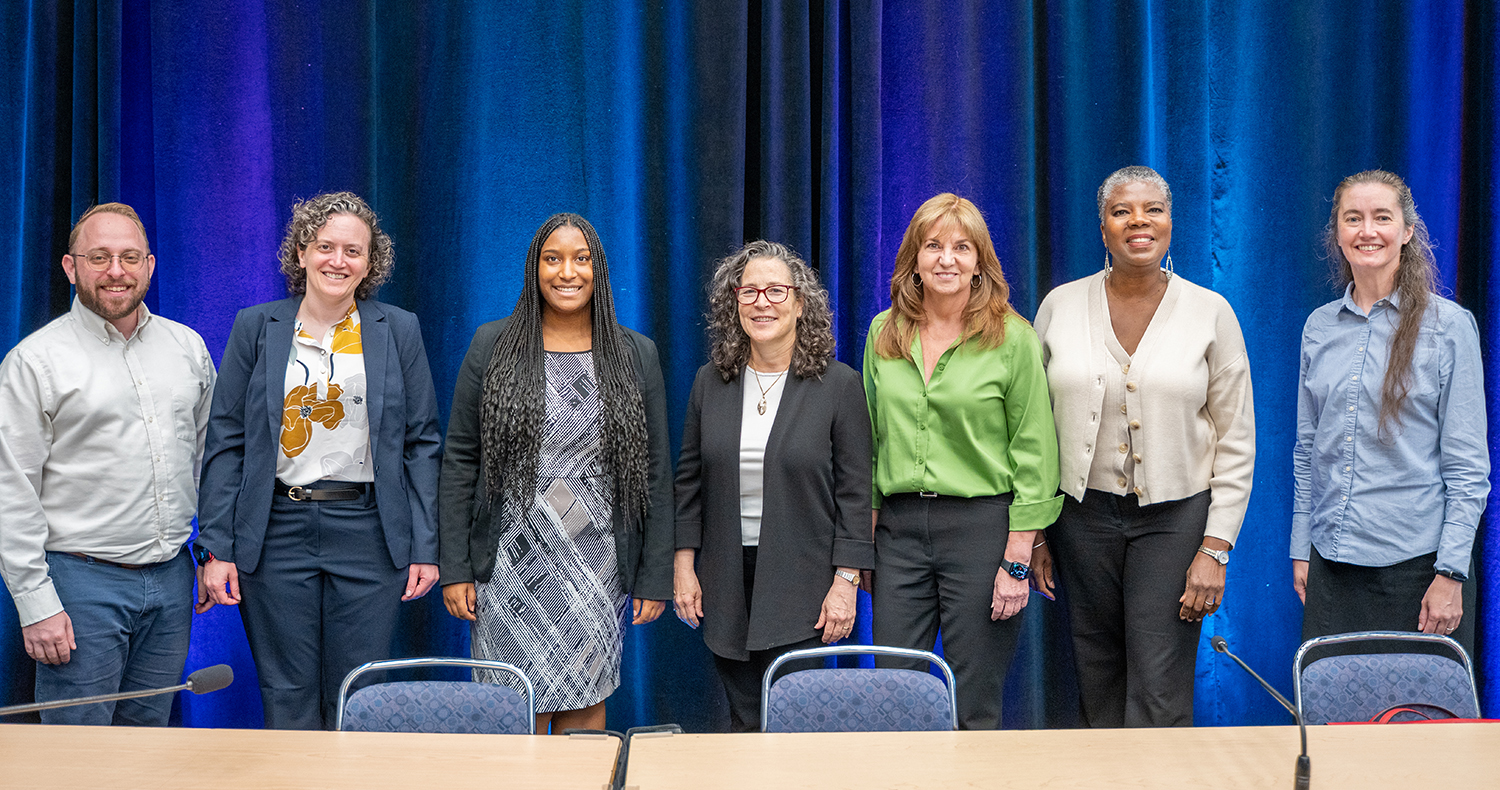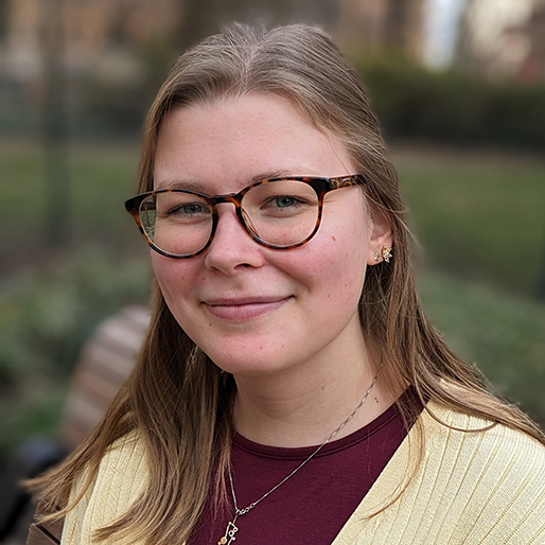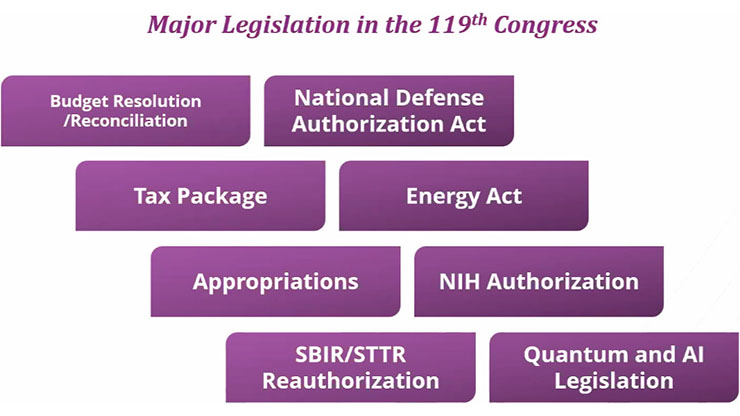Amplifying Researchers’ Voices in U.S. Science Policymaking
2025 has seen sweeping changes to the funding and priority landscape for U.S. science. Executive orders have fueled uncertainty across a variety of research disciplines, and ongoing court challenges leave many questions unresolved. Policy shifts, reductions in force, and funding issues continue to impact federal scientific agencies. Furthermore, as some research areas are facing disruptions, others are experiencing newfound levels of attention. Amidst all of this chaos, many members of the research community are struggling to determine where they stand and how they can make meaningful contributions to policy dialogues.
During the Third Joint SIAM/CAIMS Annual Meetings (AN25), which took place this summer in Montréal, Québec, Canada, a special session offered an overview of current and anticipated changes in U.S. science policy and outlined opportunities for researchers to get involved. SIAM Vice President for Science Policy Alejandro Aceves of Southern Methodist University and SIAM Chief Executive Officer Suzanne Weekes organized the event, alongside several of the speakers. The session commenced with presentations about the current federal situation from Miriam Quintal and Kiana Newman of Lewis-Burke Associates LLC, SIAM’s government relations partner in Washington, D.C. Sharon Crook of Arizona State University then chaired a panel that featured three applied mathematicians with science policy experience: Jonas Actor of Sandia National Laboratories, Emily Evans of Brigham Young University, and Rachel Levy of North Carolina State University.
SIAM has contracted with Lewis-Burke since 2001 as the Society’s first point of advocacy to advance the applied mathematics community’s interests in terms of funding, policymaking, and emerging programs and initiatives. Lewis-Burke coordinates with the SIAM Committee on Science Policy (CSP) and the SIAM Science Policy Fellowship Program, the latter of which provides an opportunity for postdoctoral fellows and early-career researchers to gain hands-on experience with U.S.-based advocacy and policymaking. Twice a year, Lewis-Burke representatives, CSP members, and SIAM Science Policy Fellows gather in Washington, D.C., to interact with congressional representatives and federal agency officers. These biannual meetings allow members of the SIAM community to advocate for important funding, learn about agency priorities, and provide feedback to lawmakers.
Current Federal Priorities That Affect the SIAM Community
Quintal kicked off the AN25 session with a primer on recent updates in federal science policy that may impact researchers in applied mathematics, computational science, and data science. Despite the current turbulence, she affirmed that there are still ways to advocate for the SIAM community’s priorities. “It really does matter to make your voices heard and talk to your lawmakers,” Quintal said.

One can understand the present federal science policy situation based on several categories: executive orders and court challenges; changes to federal agency policies and personnel; and the reconciliation, budget, and appropriations processes [2, 4]. While the Trump administration has deemphasized certain scientific interests—like climate change, infectious diseases, and social justice—other research areas have gained additional enthusiasm, such as artificial intelligence (AI), quantum computing, and nuclear energy. All of these research priorities are now generally situated in the context of global competitiveness and national security; of course, they are not spared from the reality of reduced federal funding as a whole.
The current administration’s interest in AI is particularly strong, with the recent publication of an AI Action Plan that outlines priorities for innovation and infrastructure development. “There is a real interest in partnerships between academia and industry,” Quintal said, noting the existence of opportunity spaces for the use of AI and computational tools in education and government settings. Concurrent to ongoing challenges for higher education institutions, the federal administration is promoting apprenticeships, internships, and accreditation programs — particularly those that pertain to AI.
In terms of federal agencies, the U.S. National Science Foundation along with health agencies like the U.S. National Institutes of Health and the Centers for Disease Control and Prevention have experienced a deluge of freezes, award cuts, staff reductions, reorganizations, and priority changes, with more uncertainty likely to come. The Department of Energy (DOE) seems to be faring comparatively well, with approximately flat funding set aside for the Advanced Scientific Computing Research program and ample support for AI and quantum research, though it has faced its own version of challenges such as staff departures. And while the research arm of the Department of Defense is currently in a somewhat steady state, it could undergo more scrutiny in the future.
What Does Science Advocacy Involve?
In the next segment of the AN25 session, Newman discussed effective ways to advocate for scientific priorities. She detailed Lewis-Burke’s engagement in the discourse around scientific funding and other relevant policy areas—such as immigration and taxation—to uplift certain priorities, promote higher toplines for specific programs, and enable the exchange of knowledge and expertise. “It is important for our community to be at that table and express areas that we are in line with or disagreement with,” Newman said.
At the individual level, advocacy does not necessarily have to involve a trip to Capitol Hill. Any form of engagement is valuable, including participating in local town halls and community groups or coordinating with university government relations personnel. Even calling or sending a personal email to a local, state, or federal representative can be effectual. These messages allow policymakers to understand the impacts of their decisions within their own community and react appropriately. Politicians do have a responsibility to the needs of their districts (and often a goal of re-election), so there is certainly an impetus for them to listen to and address their constituents’ concerns.
Researchers can offer lawmakers a unique value proposition by providing a technical basis for the soundness of potential policy decisions. Furthermore, delivering positive feedback on beneficial programs and initiatives can keep the research community’s priorities top of mind. “Advocacy puts applied mathematics and computational science on the map,” Newman said. “If they see that there is demand and people advocate for this, it puts more awareness on our issues.”
It can be difficult to perceive the immediate impacts of advocacy, especially given the busy schedules of staffers and representatives. But beyond the inherent worth of sharing one’s voice and providing critical feedback are advantageous possibilities to slowly grow connections and become a resource for a political office. “Advocacy is an ongoing thing as you keep building relationships,” Newman said. “You can do this over time; it’s going to be a long-term achievement.”
Workshops and special events are important occasions for scientists to influence the direction of future policy. For instance, the 2024 SIAM Quantum Intersections Convening resulted in a report with recommendations to U.S. federal agencies of strategies to bridge the gap between mathematics and quantum science [3]; a minisymposium session at AN25 overviewed some of the workshop’s key outcomes. As an upcoming opportunity, the 2026 Joint Mathematics Meetings—to be held this January in Washington, D.C.—will feature a day for Mathematical Sciences on Capitol Hill that is open to all conference attendees who sign up by November 10. After undergoing training and receiving briefing materials, participants will spend a full day engaging with congressional offices to convey the importance of the mathematical sciences.
Mathematical Experiences With Advocacy
The AN25 session concluded with a panel of three applied mathematicians who spoke about their respective experiences with science policy. Evans, who participated in the first cohort of SIAM Science Policy Fellows from 2018-2019, was motivated to gain knowledge about the functioning of the federal government that is not necessarily obvious for scientists. “I was always curious about the government, especially since funding seemed like a huge black box that I didn’t understand at first,” she said. “It was very exciting to learn how different pieces of the government work and how to advocate better.”
Actor, who is a 2024-2025 SIAM Science Policy Fellow, affirmed his interest in the communication of scientific ideas and stories in policy contexts, where narrative and research can come together to shape future directions. For her part, Levy found that her involvement with the American Association for the Advancement of Science’s Science & Technology Policy Fellowship program—a yearlong, full-time opportunity for researchers to serve in the federal government—helped her view politics and even professional relationships in a new light. “I really was able to be more effective in my own organization because of the skills and perspective that I developed,” she said.
The panelists then offered some specific anecdotes of their own impacts in policy-driven environments. Evans reminisced about her attendance at the 24th Annual Coalition for National Science Funding on Capitol Hill as a SIAM Science Policy Fellow in 2018 [1]. This event was akin to a science fair that allowed congressional representatives and staffers to learn about the importance of scientific funding for research and education. “I felt like I could really talk to them and show them that the money is really helping people,” she said.
Actor recounted his experiences with DOE’s Frontiers in AI for Science, Security, and Technology initiative, which determined how DOE would invest in AI at scale. He participated in workshops and helped to develop white papers that would ultimately facilitate the formation of priorities for future funding calls — all of which furthered his understanding of the feedback mechanisms between researchers and policymakers that determine the prospective directions of entire fields. “Language at conferences like this one gets assimilated and picked up in workshops and white papers,” Actor said.
During her time in a senatorial office, Levy made a variety of contributions: collaborating with colleagues to create a primer on quantum science for policymakers, answering phone calls from constituents, working with an external policy group on financial modeling, and forging relationships to promote new legislation. These activities underscored the value of networking, making comprises, and remaining open to tangential connections that may unexpectedly become essential. “I learned so much about relationships,” Levy said. “How do you talk to people you disagree with? That’s the most important question right now.”
As the session drew to a close, the panelists shared concrete recommendations for SIAM members who are interested in contributing to advocacy efforts. Despite the overwhelming stream of news and information, Actor encouraged the audience to stay aware of policy happenings and communicate regularly with friends and colleagues to help make sense of the deluge. He also noted the importance of tailoring advocacy messages to the appropriate audience. “Learn how to tell a story that they’ll be receptive to,” Actor said. “Not every story is going to be received the same way, depending on how it’s told.”
Similarly, Levy advised attendees to ask thoughtful questions about different people’s priorities and tease out the intersections between their personal lives and their policy leanings. “Be relatable and focus on what people care about and how they spend their time,” she said. Evans agreed about the merit of building connections. “The one thing I would recommend you do is talk to people,” she said, referencing not only local and federal political representatives but also friends, neighbors, and even new acquaintances. “The more you advocate and talk to people, the more you can talk about the importance of funding science and math, and the more that message is going to get out.”
References
[1] Evans, E.J. (2020, September 1). It’s all about the story: Reflections of a former Science Policy Fellowship recipient. SIAM News, 53(7), p. 8.
[2] Kunze, J. (2025, April 1). SIAM webinar examines recent U.S. federal actions and outlook for the applied mathematics community. SIAM News, 58(3), p. 5.
[3] Kunze, J. (2024, October 11). Entangling applied mathematics and quantum science at the 2024 SIAM Quantum Intersections Convening. SIAM News Blog. Retrieved from https://www.siam.org/publications/siam-news/articles/entangling-applied-mathematics-and-quantum-science-at-the-2024-siam-quantum-intersections-convening.
[4] Weekes, S., & Aceves, A. (2025, May 12). Message to the SIAM community: 2026 U.S. federal budget request. SIAM News Blog. Retrieved from https://www.siam.org/publications/siam-news/articles/message-to-the-siam-community-2026-us-federal-budget-request.
About the Author
Jillian Kunze
Master's student, Drexel University
Jillian Kunze is the former associate editor of SIAM News. She is currently a master’s student in data science at Drexel University.

Stay Up-to-Date with Email Alerts
Sign up for our monthly newsletter and emails about other topics of your choosing.





